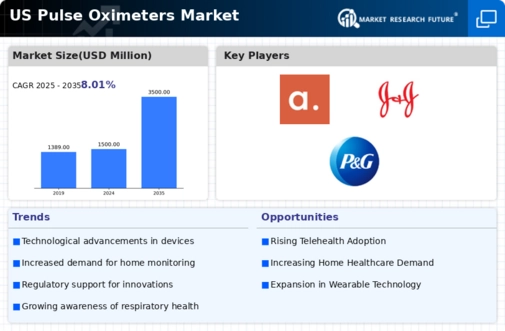Growing Aging Population
The demographic shift towards an aging population in the US is a critical driver for the pulse oximeters market. As individuals age, they often experience a decline in respiratory function, leading to an increased need for monitoring devices. The US Census Bureau projects that by 2030, all baby boomers will be over 65 years old, significantly impacting healthcare demand. This demographic trend suggests a growing market for pulse oximeters, as older adults are more likely to require regular monitoring of their oxygen levels. Healthcare providers are increasingly recommending these devices for home use, further driving market growth. The pulse oximeters market is poised to benefit from this demographic shift, as the need for effective monitoring solutions becomes more pronounced.
Expansion of Telehealth Services
The expansion of telehealth services in the US is emerging as a significant driver for the pulse oximeters market. As healthcare providers increasingly adopt telemedicine, the need for remote monitoring tools has surged. Pulse oximeters are integral to telehealth, enabling healthcare professionals to assess patients' oxygen levels without requiring in-person visits. This trend is particularly relevant in managing chronic conditions, where continuous monitoring is essential. The market is expected to see a substantial increase in demand for pulse oximeters as telehealth becomes more mainstream. Furthermore, the convenience and accessibility of telehealth services are likely to encourage more individuals to utilize pulse oximeters, thereby expanding the market reach. This shift towards digital healthcare solutions indicates a promising future for the pulse oximeters market.
Increased Focus on Preventive Healthcare
The pulse oximeters market is experiencing growth due to a heightened emphasis on preventive healthcare in the US. As healthcare systems shift towards proactive management of health conditions, the demand for devices that facilitate early detection of potential issues is rising. Pulse oximeters play a crucial role in this paradigm by allowing individuals to monitor their oxygen levels conveniently. The market is projected to grow at a CAGR of around 8% over the next five years, driven by this preventive approach. Additionally, the integration of these devices into routine health check-ups is becoming more common, further solidifying their position in the healthcare landscape. This trend indicates a broader acceptance of pulse oximeters as essential tools for maintaining health and preventing complications.
Rising Prevalence of Respiratory Disorders
The increasing incidence of respiratory disorders in the US is a notable driver for the pulse oximeters market. Conditions such as chronic obstructive pulmonary disease (COPD) and asthma are becoming more prevalent, necessitating effective monitoring solutions. According to recent health statistics, approximately 16 million Americans are diagnosed with COPD, which underscores the demand for reliable monitoring devices. Pulse oximeters serve as essential tools for both patients and healthcare providers, enabling real-time assessment of oxygen saturation levels. This trend is likely to propel the pulse oximeters market, as healthcare professionals seek to enhance patient outcomes through timely interventions. Furthermore, the growing awareness of respiratory health is expected to drive consumer demand for these devices, contributing to market expansion in the coming years.
Technological Innovations in Device Design
Technological advancements in the design and functionality of pulse oximeters are significantly influencing the market. Innovations such as wireless connectivity, smartphone integration, and enhanced accuracy are making these devices more user-friendly and appealing to consumers. The introduction of portable and compact models has expanded the usability of pulse oximeters, allowing for greater accessibility in various settings, including home healthcare. As of November 2025, the pulse oximeters market is witnessing a surge in demand for advanced features that cater to tech-savvy consumers. This trend is likely to continue, as manufacturers invest in research and development to create devices that meet evolving consumer expectations. The competitive landscape is expected to intensify as companies strive to differentiate their products through innovative features.














Leave a Comment